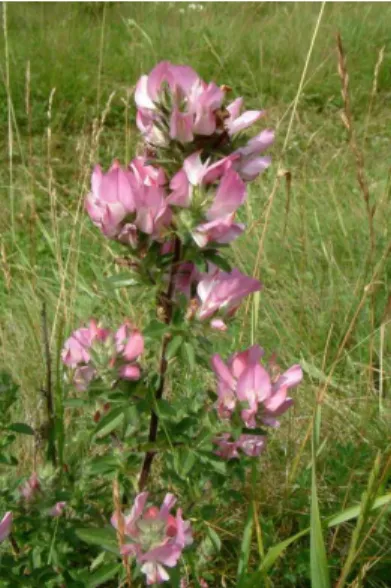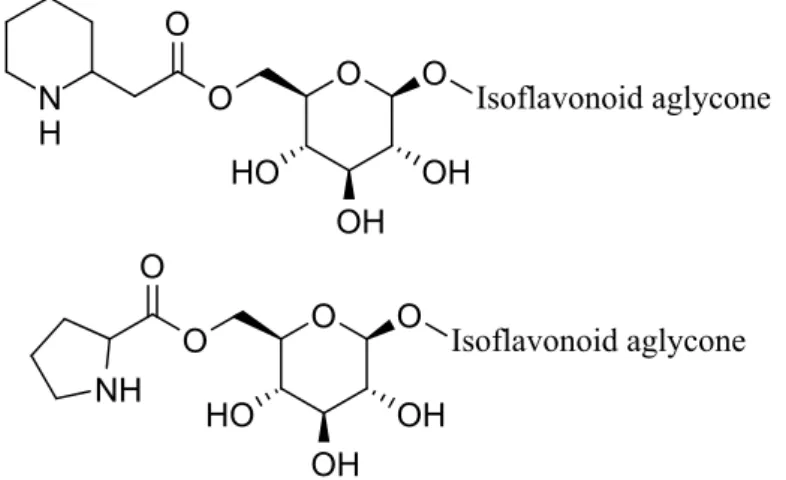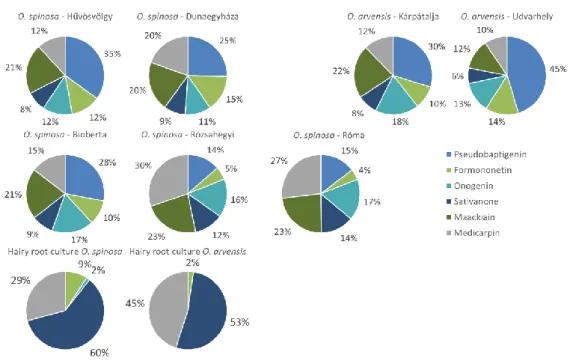Phytochemical analysis of Ononis species
Doctoral theses
Nóra Gampe
Semmelweis University
Pharmaceutical Sciences Doctoral School
Supervisors: Szabolcs Béni, Ph.D.
László Kursinszki, Ph.D.
Reviewers: Márta Mazákné Kraszni, Ph.D.
Dezső Csupor, Ph.D.
Chair of final examination committee: Dr. Imre Klebovich, D.Sc.
Members of final examination committee:
Éva Ledniczkyné Lemberkovics, Ph.D.
Zsuzsanna Hajdú, Ph.D.
László Abrankó, Ph.D.
Budapest
2019
2 Introduction
Natural products and plant derived remedies accompanied us since prehistoric times and they are still a popular choice of self-healing. Although, many herbal extracts are proved to have beneficial health effects, the responsible components are undefined in the majority of cases. With the help of phytochemical and phytoanalytical techniques, the aim of pinpointing the most potent molecules in the herbal drugs can be executed. The results of these studies are not only feeding the intrinsic curiosity – How and why does it work? – but can be the base of the quality control of herbal drugs and preparations. Taking advantage of the capacities of biotechnology, the metabolite profile of the plant can be fine-tuned, resulting in easier accessibility to the beneficial molecules. Furthermore, with the structural knowledge of the effective compounds, new semisynthetic, structurally optimized molecules can be created.
The roots of Ononis spinosa L. (spiny restharrow, Figure 1) and O. arvensis L. (field restharrow, Figure 2), are well known example of herbal drugs, where the ethnomedicinal use is confirmed by in vitro and in vivo tests, however, the exact compounds responsible for the effects are unknown. Ononis species are a member of the Leguminosae family, and widely spread in Europe and in the Mediterranean region. It is known for thousands of years that spiny restharrow root possesses diuretic effect and the drug is official in many pharmacopoeias. Nowadays several spiny restharrow root products are on the market: it is available in the form of single herbal substance products, in herbal teas or liquid extracts combined with other diuretic herbs. Preparations from spiny restharrow root are conventionally used as infusions for the stimulation of diuresis, to treat inflammatory conditions of the lower urinary tract and as a remedy for kidney disorders such as gravels and small stones. These indications were confirmed by animal studies but there is no evidence for the active compound(s) of the root responsible for the diuretic effect. Recent in vivo and in vitro experiments certified that the root extract holds antioxidant, analgesic, antimicrobial, anti-inflammatory and wound-healing features.
Phytosterols, phenolic acids, essential oil, coumarins, flavonoids and a specific triterpene, α-onocerin, beside isoflavonoids and their glucosides are the major constituents in restharrow root species (Figure 3). Isoflavonoids can have phytoestrogenic activity due to their structural similarity to estradiol. Moreover, isoflavonoids can play an important role in the prevention and treatment of hormone-dependent cancers, osteoporosis, cardiovascular diseases and diseases of civilization like metabolic syndrome or polycystic ovary syndrome.
As a consequence, plants with high isoflavonoid content (such as soy or red clover) are under thorough investigations. Interestingly, during the traditional use of Ononis species none of the
3
aforementioned effects was observed, therefore we aimed at analyzing the isoflavonoids in O.
spinosa and O. arvensis roots and in their in vitro hairy root cultures.
Figure 3: The six most important isoflavonoid aglycones found in Ononis species Figure 2: Ononis spinosa L. Figure 1: Ononis arvensis L.
4 Objectives
The main aim of this work was to characterize the isoflavonoid profile of the Ononis species native to Hungary: Ononis spinosa L. and Ononis arvensis L., since isoflavonoid derivatives possess numerous promising pharmacological effects. Qualitative and quantitative literature data on the isoflavonoid composition of the two Ononis species is limited to the compounds available as standard substances and the other isoflavonoid derivatives have not been studied. Although in vitro cultures were made from both species, there is no available information about the isoflavonoid content of these samples. Considering the above mentioned, our specific aims were the followings:
1. To explore the isoflavonoid profile of the roots of O. spinosa and O. arvensis in details and acquire structural information by the means of HPLC-DAD-ESI-MS/MS and UHPLC- DAD-ESI-Orbitrap-MS/MS.
2. For compounds, which could not be identified solely by mass spectrometry, our objective was to elaborate isolation methods and to characterize those using orthogonal spectroscopic techniques.
3. For the quantitative determination of isoflavonoid aglycones in the herbal drugs and for the determination of the total isoflavonoid content in O. spinosa, O. arvensis and their in vitro hairy root cultures, our aim was to develop and validate a HPLC-DAD method.
5 Materials and methods
The aqueous-methanolic extracts of the various root samples were screened first by HPLC-DAD-ESI-MS/MS and UHPLC-DAD-ESI-Orbitrap-MS/MS for the target isoflavonoids. In positive ionization mode, the fragmentation profile yielded the so-called retro Diels-Alder reaction could promote the differentiation of structurally similar aglycones.
With the application of high-resolution instruments, an accurate mass determination could be performed. As a result, the molecular formula of the investigated substance could be calculated, and isobar molecules and molecule fragments can be differentiated.
However, in the structural elucidation of unknown molecules, where no benchmark spectra were available, the application of various NMR techniques is inevitable. This technique is essential to distinguish positional isomers of flavonoids and isoflavonoids, determines the linkage of the glycosidic bond and the site of esterification with a complete resonance assignment. On the other hand, NMR requires considerably large amounts of substances, therefore preparative sample isolation has to be performed.
The isolation of the unknown compounds was executed using various separation techniques, including flash- and preparative chromatography and purification on cartridges filled with weak cation exchange resin.
To closing the gap between the biological effects and the responsible molecules, it is crucial to gain information about the quantitative ratios of the extract components. For the quantitative assessment of the isoflavonoids in O. spinosa and O. arvensis root and in their in vitro cultures the samples containing a diverse set of isoflavonoid derivatives were subjected to enzymatic hydrolysis to obtain the free aglycone forms exclusively. These samples were then analyzed by a HPLC-DAD method using external calibration. During the validation, the linearity range, limit of detection and quantitation, inter- and intra-assay precision and accuracy were defined.
6 Results
1. As formononetin, pseudobaptigenin, maackiain and medicarpin along with their glycosidic derivatives had been described in these species before, their identification could only be based on their fragmentation profile and exact mass. The presence of genistein, daidzein and biochanin A derivatives could be excluded based on the MS data, although, these compounds had been mentioned in the literature of the plants. Cuneatin and 2’-methoxy formononetin were firstly characterized in the extract of O. spinosa and O. arvensis based on the similarity of their fragmentation profile to those of formononetin and pseudobaptigenin.
2. As onogenin and sativanone and their derivatives were described for the first time in O. spinosa and no reference mass spectra were available, these compounds were isolated, and their structure were corroborated by NMR experiments (Figure 3).
3. Calycosin and calycosin D are structural isomers, they only differ in a position of a methoxy group. Since using mass spectroscopy no significant difference was observed between the fragmentation spectra of the two molecules, a standard substance was used to identify the aglycone by its retention time. The glucoside and glucoside malonate derivatives were isolated, and their structures were investigated by NMR spectroscopy.
4. Puerol derivatives are special phenolic lactones which can be found in various methoxylated and glycosylated forms. For the exact and detailed structural discovery, the two pairs of puerol derivatives (two aglycones and two glucosides) were isolated. Based on NMR studies the Ononis samples contained puerol A and its 2’-O-glucoside and clitorienolactone B and its 4’-O-glucoside, which was characterized for the first time.
5. One of the major components of the Ononis extracts had a special fragmentation pattern which showed no similarity with isoflavonoids. This compound was isolated, and its structure was identified as maltol glucoside hydroxy-methyl-glutarate ester (licoagroside B).
The presence of this compound is firstly described in the genus, as licoagroside B had been isolated from Glycyrrhiza species only.
6. During the Iz analysis in positive ionization mode, some very characteristic peaks were observed, which could not be detected on the DAD chromatograms. Applying the N- rule, these molecules seemed to be two sets of easily protonating N-containing derivatives of isoflavonoids. As alkaloids and other N-containing compounds had not been described in the roots of Ononis species, a method for the isolation of the set of molecules in higher concentration was developed. Based on the NMR results, these molecules were the homopipecolic acid esters of six isoflavonoid glucosides. According to the MS/MS data, the
7
other set of N-containing compounds were homologues of the homopipecolic acid esters (Figure 4). However, the plant material contained these homologues in such a low concentration that the isolation could not be performed. Therefore, an indirect method was implemented. Firstly, the isolated N-containing compounds were hydrolyzed to obtain the two types of beta amino acids, and then the free amino acids were investigated by the means of HPLC-ESI-MS/MS using standard substances for comparison. With this method, it can be confirmed that the plant material contained homopipecolic acid and homoproline. This is the first time that these two beta amino acids are described in the Leguminosae family and in the form of isoflavonoid glucoside esters.
Figure 4: The structures of homopipecolic acid- and homoproline esters of isoflavonoid glucosides
7. Since isoflavonoids can be found in the plant samples in a very complex form, the samples should be simplified prior to quantitative analysis. Although in the literature acidic hydrolysis is the most widely used method, in our case it was not applicable because of the decomposition of pterocarpans. Consequently, a hydrolytic method based on the endogenous glucosidase enzyme of the plant was developed.
8. Using the optimized HPLC-DAD method the extracts of three commercial O. spinosa, two collected samples from both O. spinosa and O. arvensis and one in vitro hairy root sample of each plant were assessed regarding their isoflavonoid content (Figure 5). This is the first time that the quantity of all six major isoflavonoids was defined. The method was validated according to the guidelines of the ICH, EMEA and FDA.
8
Figure 5: Total isoflavonoid content of O. spinosa and O. arvensis samples
9. The isoflavonoid profiles of in vitro hairy root cultures of Ononis species were firstly characterized. Based on the qualitative and quantitative results, it can be concluded that the enzymatic and biosynthetic function of these cultures differ markedly from the free-range plants, since they only produced methoxylated isoflavones, isoflavanones and pterocarpans (Figure 6). Furthermore, O. spinosa hairy root culture contained outstandingly high isoflavonoid content.
Figure 6: Relative amount of isoflavonoid aglycones in O. spinosa and O. arvensis samples in vitro samples
collected O. spinosa
collected O. arvensis commercial O. spinosa
9 Conclusions
During the qualitative phytochemical analysis of the root extract made from O.
spinosa and arvensis, a total of 47 compounds were identified. These are mostly the glucosides, glucoside malonates and aglycones of isoflavonoids, but some special phenolic lactones – puerol A and clitorienolactone B – and a maltol derivative were described, too. The presence of calycosin, sativanone, onogenin and their derivatives were firstly proved in O.
spinosa, while in O. arvensis pseudobaptigenin, calycosin and sativanone had not been mentioned before. The calycosin content could be established by the biosynthetic pathway of isoflavonoids, as calycosin serves as an intermediate between formononetin and pseudobaptigenin. The presence of 2’-methoxy isoflavones and isoflavanones is justifiable by the biosynthesis, too. Genistein, biochanin A and daidzein had been previously reported in O.
spinosa root, however, we could not confirm these results. Furthermore, the biosynthetic origin of formononetin is liquiritigenin, while genistein and biochanin A are synthesized from naringenin.
As new isoflavonoid derivatives, beta amino acid esters were characterized for the first time, as well. Homopipecolic acid was described before in Lycopodium species as an intermediate of the synthesis of Lycopodium alkaloids, while homoproline was isolated from Asteraceae species, as a precursor of pyrrolizidines, but their co-occurrence has never been reported in plants and their biosynthetic origin is not known. Their function might be a nitrogen reservoir, or they can protect the plants from insects as toxic amino acid analogues.
Since free-range and commercially available Ononis samples contain an average of 0.97 g/100 g isoflavonoids, their total isoflavonoid content could be considered very high. On the other hand, the isoflavonoid profile of soy and Ononis species is very distinct, so deductions about the phytoestrogenic effect of the plants are hard to make. Beside isoflavones, Ononis species proved to contain a remarkable amount of isoflavanones and pterocarpans, which possess convincing biological and pharmacological effects. Moreover, the hairy root cultures of O. spinosa could be promising tool to produce methoxylated isoflavones, isoflavanones and pterocarpans.
10 List of own publications
Regarding the topic of the thesis:
Gampe N, Darcsi A, Lohner S, Béni S, Kursinszki L. (2016) Characterization and identification of isoflavonoid glycosides in the root of Spiny restharrow (Ononis spinosa L.) by HPLC-QTOF-MS, HPLC–MS/MS and NMR. J Pharmaceut Biomed, 123: 74-81.
Gampe N, Darcsi A, Kursinszki L, Béni S. (2018) Separation and characterization of homopipecolic acid isoflavonoid ester derivatives isolated from Ononis spinosa L. root. J Chrom B, 1091: 21-28
Gampe N, Darcsi A, Nagyné Nedves A, Boldizsár I, Kursinszki L, Béni S. (2018) Phytochemical analysis of Ononis arvensis L. by liquid chromatography coupled with mass spectrometry. J Mass Spec
Other publications:
Addotey JN, Lengers I, Jose J, Gampe N, Béni S, Petereit F, Hensel A: Isoflavonoids with inhibiting effects on human hyaluronidase-1 and norneolignan clitorienolactone B from Ononis spinosa L. root extract. Fitoterapia, 130:169-174


